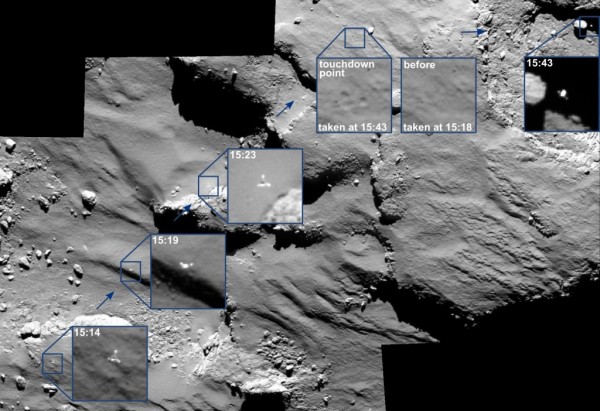
Rosetta blog, which is a wonderful place to go for the most up-to-date information about ESA’s wonderful comet mission, posted the mosaic image above earlier today (November 17, 2014). It’s comprised of a series of images captured by the Rosetta spacecraft’s OSIRIS camera over a 30-minute period spanning the Philae lander’s first touchdown on the surface of Comet 67P/Churyumov-Gerasimenko on November 12. Rosetta blog says:
The time of each of image is marked on the corresponding insets and is in GMT. A comparison of the touchdown area shortly before and after first contact with the surface is also provided.
The images were taken with Rosetta’s OSIRIS narrow-angle camera when the spacecraft was 17.5 km from the comet center, or roughly 15.5 km from the surface. They have a resolution of 28 cm/pixel and the enlarged insets are 17 x 17 meters.
From left to right, the images show Philae descending towards and across the comet before touchdown. The image taken after touchdown, at 15:43 GMT, confirms that the lander was moving east, as first suggested by the data returned by the CONSERT experiment, and at a speed of about 0.5 meters/second.
The final location of Philae still isn’t known, by the way. It apparently landed in the shadow of a cliff on the comet (before Rosetta, who knew comets had cliffs?), which is what caused its solar panels to be unable to draw enough power to re-charge the lander’s batteries, causing the landed to turn itself off on Friday, November 14. This may not be the end of the Philae lander, however. As the comet continues to move around the sun, its “seasons” will change. In other words, the sun will move higher in the comet’s sky, maybe enabling the lander to get enough sunlight eventually to power up again.
For now, the Philae lander is silent, and its whereabouts on the comet’s surface are unknown. The Rosetta imaging team said on November 17 it is:
… confident that combining the CONSERT ranging data with OSIRIS and navcam images from the orbiter and images from near the surface and on it from Philae’s ROLIS and CIVA cameras will soon reveal the lander’s whereabouts.
The Rosetta mothership is operating normally, by the way, and will continue to return data about its comet for many months to come! So you can expect more excitement from this great mission.
Bottom line: Never-before-seen images of a bouncy comet landing! Shows Philae lander attempting to touch down in the weak gravity field of Comet 67P/Churyumov-Gerasimenko.











